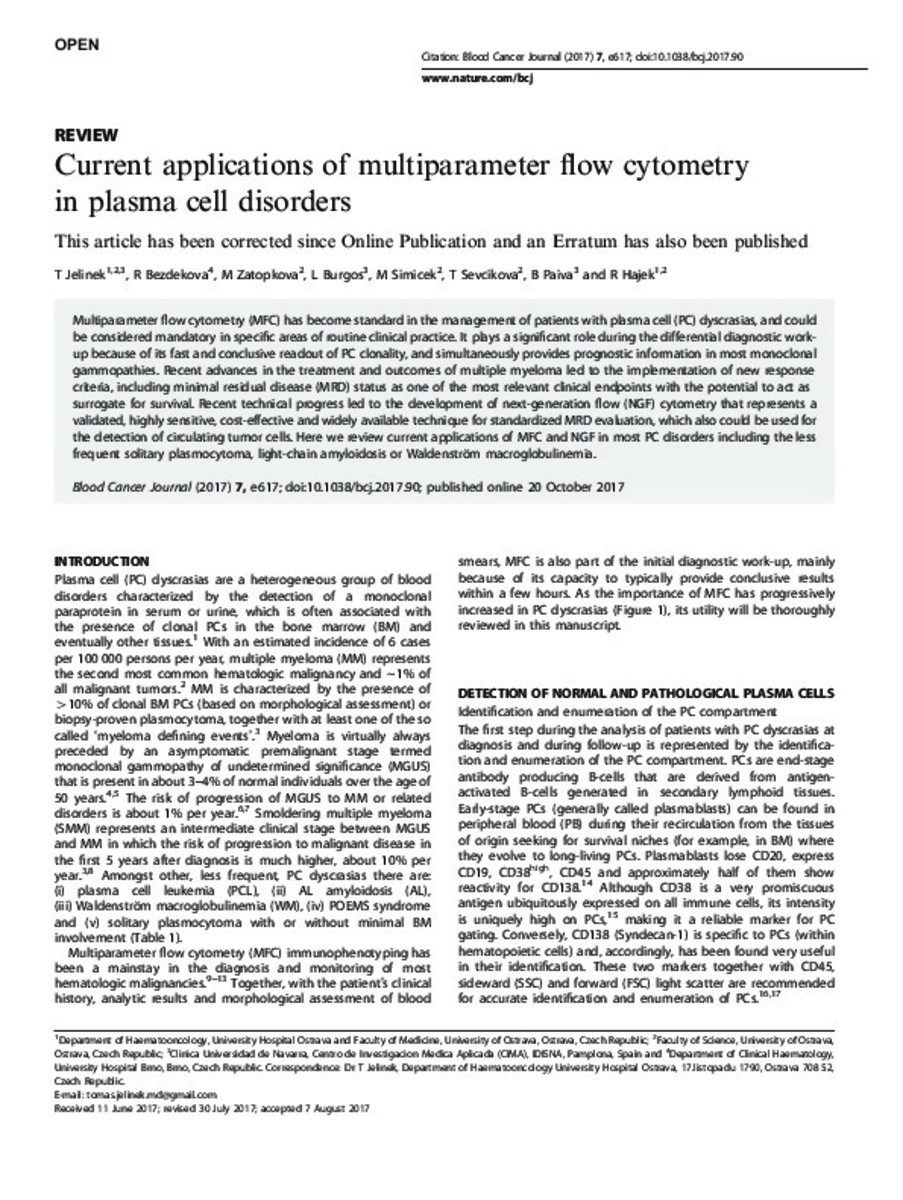Registro completo de metadatos
| Campo DC | Valor | Lengua/Idioma |
|---|---|---|
| dc.creator | Jelinek, T. (T.) | - |
| dc.creator | Bezdekova, R. (R.) | - |
| dc.creator | Zatopkova, M. (M.) | - |
| dc.creator | Burgos, L. (Leire) | - |
| dc.creator | Simicek, M. (M.) | - |
| dc.creator | Sevcikova, T. (T.) | - |
| dc.creator | Paiva, B. (Bruno) | - |
| dc.creator | Hajek, R. (R.) | - |
| dc.date.accessioned | 2018-05-03T11:47:27Z | - |
| dc.date.available | 2018-05-03T11:47:27Z | - |
| dc.date.issued | 2017 | - |
| dc.identifier.citation | Jelinek, T. et al., 2017. Current applications of multiparameter flow cytometry in plasma cell disorders. Blood Cancer Journal, 7, p.e617. Available at: http://dx.doi.org/10.1038/bcj.2017.90. | es |
| dc.identifier.issn | 2044-5385 | - |
| dc.identifier.uri | https://hdl.handle.net/10171/52009 | - |
| dc.description.abstract | Multiparameter flow cytometry (MFC) has become standard in the management of patients with plasma cell (PC) dyscrasias, and could be considered mandatory in specific areas of routine clinical practice. It plays a significant role during the differential diagnostic work-up because of its fast and conclusive readout of PC clonality, and simultaneously provides prognostic information in most monoclonal gammopathies. Recent advances in the treatment and outcomes of multiple myeloma led to the implementation of new response criteria, including minimal residual disease (MRD) status as one of the most relevant clinical endpoints with the potential to act as surrogate for survival. Recent technical progress led to the development of next-generation flow (NGF) cytometry that represents a validated, highly sensitive, cost-effective and widely available technique for standardized MRD evaluation, which also could be used for the detection of circulating tumor cells. Here we review current applications of MFC and NGF in most PC disorders including the less frequent solitary plasmocytoma, light-chain amyloidosis or Waldenström macroglobulinemia. | es_ES |
| dc.description.sponsorship | We give special thanks to Shira Timilsina, MD for English language editing. This work was supported by the MH CZ—DRO—FNOs/2017 and Ministry of Health (17-30089A); by the Institutional Development Plan of University of Ostrava (IRP201550), by SGS18/PrF/2017–2018 and by ‘Strengthening international cooperation in science, research and education, projet ID: 01211/2016/RRC’. It was also supported by the International Myeloma Foundation Black Swan Research Initiative and the European Research Council (ERC) 2015 Starting Grant (MYELOMA-NEXT). | es_ES |
| dc.language.iso | eng | es_ES |
| dc.relation | info:eu-repo/grantAgreement/EC/H2020/680200/EU | - |
| dc.rights | info:eu-repo/semantics/openAccess | es_ES |
| dc.subject | Materias Investigacion::Ciencias de la Salud::Hematología | es_ES |
| dc.subject | Citometría | es_ES |
| dc.title | Current applications of multiparameter flow cytometry in plasma cell disorders | es_ES |
| dc.type | info:eu-repo/semantics/article | es_ES |
| dc.relation.publisherversion | https://www.nature.com/articles/bcj201790 | es_ES |
| dc.description.note | This work is licensed under a Creative Commons Attribution 4.0 International License. The images or other third party material in this article are included in the article’s Creative Commons license, unless indicated otherwise in the credit line; if the material is not included under the Creative Commons license, users will need to obtain permission from the license holder to reproduce the material. To view a copy of this license, visit http://creativecommons.org/licenses/ by/4.0/ | es_ES |
| dc.identifier.doi | 10.1038/bcj.2017.90 | - |
Ficheros en este ítem:
Estadísticas e impacto
Los ítems de Dadun están protegidos por copyright, con todos los derechos reservados, a menos que se indique lo contrario.






